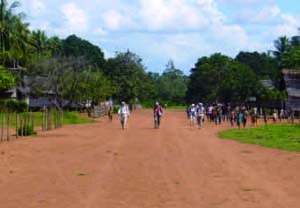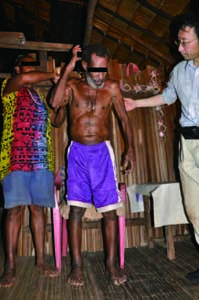Collaborators: KUZUHARA, Shigeki (Suzuka University of Medical Science, Faculty of Health Science)
KOKUBO, Yasumasa (MieUniversity, Graduate School of Regional Innovation Studies)
Eva Garcia del Saz (Kochi University, Center for Regional & International Collaboration)
MATSUBAYASHI, Kozo (Kyoto University, Center for Southeast Asian Studies)
FUJISAWA, Michiko (Kyoto University, Center for Southeast Asian Studies)
Term:2013-2014
Outline of Research:

Visitation to Ogorite, farthest village along the Ia River by the research members
Few follow-up studies have been made on the high incidence of amyotrophic lateral sclerosis (ALS) and parkinsonism in Papua, Indonesia since a survey was first
done in 1991. To clarify the clinical epidemiology of ALS and parkinsonism in Papua, we have examined the recent prevalence and characteristics of these diseases in the area. Compared with the previous report, the recent prevalence of pure ALS in the south costal area in Papua might be lower but recently many cases ALS and Parkinsonism overlap are still recognized. Although previously, indigenous people had a traditional lifestyle such as hunting, gathering, fishing and eating Sago palm, the recent increase of rubber planters has resulted in a lifestyle change with the spread of the market economy in Papua. Continuous follow-up surveys will be carried out focusing on clinical epidemiology and etiology of neuro-degenerative diseases in association with ecological and environmental changes in Papua.
Description:

Physical examination of a patient of neurodegenerative disease
Along with Guam and Kii in Japan, Papua (Indonesia) is one of the foci with the highest incidence of ALS and parkinsonism in the world. The disappearance of the high incidence of ALS and Parkinsonism in Guam and Kii has been reported, as was a decline of ALS in Papua. However, there have been few follow-up surveys in Papua since 1991. We carried out a survey for neurodegenerative diseases from 2001 to 2013 and clarified a high prevalence of ALS and parkinsonism in Papua.
The purpose of this research is to clarify the association of clinical epidemiology with ecological and environmental changes in Papua.
It is significant that there are still many cases showing pure ALS and an overlap of ALS, parkinsonism and cognitive impairment in Papua, different from the recent situation in Guam and Kii. The changing patterns of decrease of ALS and increase of parkinsonism in Papua might be caused by environmental changes and socioeconomic factors and aging.
It is expected that etiology or risk factors of the neuro-degenerative diseases will be disclosed in association with environmental factors.
